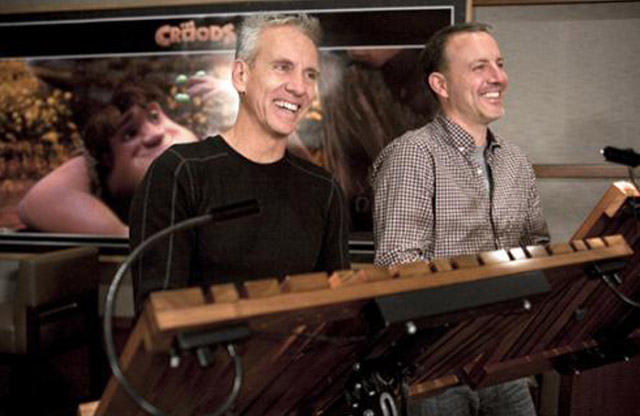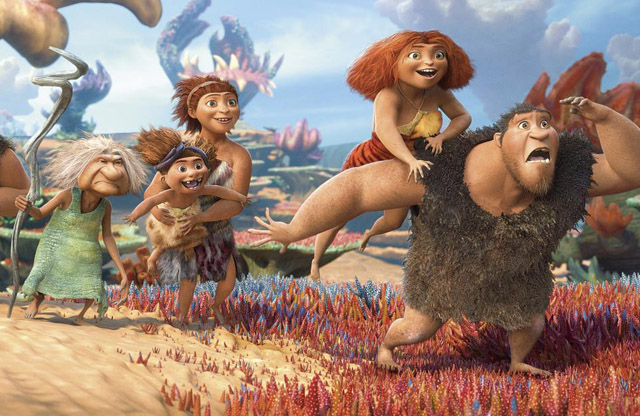CHICAGO – In anticipation of the scariest week of the year, HollywoodChicago.com launches its 2024 Movie Gifts series, which will suggest DVDs and collections for holiday giving.
Interview: Directors Kirk De Micco, Chris Sanders of ‘The Croods’
CHICAGO – The fast, funny and brightly thematic “The Croods” is the latest animated epic to come out of DreamWorks Studios, and a couple of veterans in the cartoon game, Kirk De Micco and Chris Sanders, are both the writers and directors of this vivid look into a prehistoric cave family and their evolutionary adventures.
“The Croods” are voiced by Nicolas Cage (Grug), Emma Stone (Eep), Catherine Keener (Ugga), Ryan Reynolds (Guy) and Cloris Leachman (Gran). They live to survive, but mostly hide in their dark cave from the outside elements. It is Eep who wants more out of life, and finds it with the adventurous Guy, who exists to enlighten himself.
 Photo credit: DreamWorks Animation |
The writers and directors of this modern stone age fantasy are Kirk De Micco and Chris Sanders. Both are veterans of animation, De Micco previously wrote the screenplay for “Quest for Camelot” (1998) and wrote/directed the recent “Space Chimps” (2008). Chris Sanders is an old Walt Disney veteran, breaking in as an animator there during “The Little Mermaid” (1989) period and developed the stories for classics “The Lion King” (1994) and “Aladdin” (1992), and also wrote the screenplays for “Mulan” (1998) and “Lilo & Stitch” (2002, which he also directed). “The Croods” is Sander’s second film for DreamWorks Studio, after he wrote and co-directed the mega-successful “How to Train Your Dragon” (2010). Sanders also voices the character of Belt in “The Croods”
HollywoodChicago spoke with Kirk De Micco and Chris Sanders about the art of creating the modern animated film, plus some explorations into cartoon physics.
HollywoodChicago.com: It’s appropriate that I ask this question considering the themes in your film. What came first, the chicken of the caveman story or the egg of their quest for the light?
Kirk De Micco: Chicken of the Eggman? [laughs] I started writing this idea in 2004 with John Cleese [of Monty Python fame]. John and I had written scripts over at Disney, and some DreamWorks people had read them. So they invited us over to pitch some ideas, and one was a kernel of an idea about two cavemen, sort of the stone age meets ‘Midnight Run’ for the two characters – one was advanced and one was a Luddite.
What stayed resonant throughout the process of development was this fear of change. John has a very healthy fear of technology, that it will ruin the world and bring it to its knees. It was more satirical then, but it evolved into a more emotional resonance regarding that fear of change. And that is the fear that is around you, inside your family, and the fear that a father is losing a daughter to a guy who doesn’t think like he does.
HollywoodChicago.com: So going towards the light, and the ‘enlightened’ theme also evolved from that idea?
Chris Sanders: Yes, it began with a character trait in the daughter, she was the Crood that least liked being in the cave. So before she went back inside, we added this bit where she took a great risk by wanting to touch the light one last time. As we continued to work on the story – and remember the animation process is very long – situations grew out of the idea almost on their own.
That bit about her touching the light became so iconic, that it resonated to the end of the film. One of the things I love about the theme of following the light, is that it’s specific, but at the same time vague enough so we could assign a multitude of meanings to it, and all of them are ultimately correct.
HollywoodChicago.com: You had to invent several hybrid animals, pre-evolved animals and plant life. What prehistoric eras were you focusing on or did you just throw them in the air and mix them up?
De Micco: The ‘gimme’ for this movie is we wanted the characters to be grounded, for the audience to understand their journey and relate to it. So we set it in a world of the ‘time between times,’ an undiscovered era – The ‘Croodacious’ Period. [laughs] As we look at character studies, our artists were combining things, which made us laugh. But this also relates to the theme, because we wanted the world to be changing under Grug’s [Nicolas Cage] feet, and that there were some evolutionary ‘dead ends’ out there that might not make it to the next world. [laughs]
HollywoodChicago.com: Since marketing an animated film now relies on familiar celebrity voices actors to help sell it, how do you as directors focus on who you want and how to get them for ‘The Croods’?
Sanders: The important thing is that they embody the character that you want them to. At these recording sessions, we always have to remember that we’re going to leave those sessions with just their voice. And there are some performers whose acting is more in their face than voice. But Emma Stone and Nicolas Cage are not only amazing on screen, but when you hear the way they speak, they also fully inhabit their voices. They had the right vibe, warmth and appeal, and what really shined was that they were inventive in the room. That was a real boon.
De Micco: We were seeking the Nicolas Cage of ‘The Weatherman.’ The beleaguered, weight-of-the-world on his shoulders, trying his very hardest. And that’s what we got from him.
HollywoodChicago.com: I noticed in ‘The Croods’ that the characters were able to fall from great distances and remain unhurt. What are your favorite application of cartoon physics and how often do you want to use it or get away with it?
De Micco: The great thing about caveman, and the reason the character is designed the way they are, we were positive that there bones were ultra thick. You can take a 2x4 and smash it over Grug’s head and he would say, ‘what just happened?’ Eep has an athlete’s body, and can leap great distances, she’s one notch below super hero.
Sanders: We tweak the audience with the cave painting prologue, indicating that the Croods are mortal, and then we proceed to present them going out for breakfast, which was opposite to mortality, and over the top. We needed to reset the dial of the audience as to their perception of what that world is like, what the characters are like and what they have to do to survive. So they can fall great distances, they can take a lot of impact and they can run really fast. We told the ‘camera’ animators that when Eep takes off to run, she’s going 60 miles an hour.
De Micco: We both love Looney Tunes so this was an opportunity to do that, because these guys are that strong.
HollywoodChicago.com: Chris, since you’ve had experience in the Disney system, there are consistent accusations that the culture within the company has gotten more corporate and bottom line. Counter to that, how do you think the company has improved in the modern era to keep producing consistently interesting animation?
Sanders: Well, when I started in Saturday morning animation, that was directly driven by product. I never had that feeling at Disney, where the product was even a consideration. It’s the same at Dreamworks. It’s really deep in the process when you finally get, ‘wow, I hope they make a toy of this.’ It was all was story driven at Disney, which was nice.
I did get to a point at Disney when I felt it was doubtful that I’d be able to write and direct the kind of animated films that I like. That was what prompted me to go to DreamWorks. It was ‘American Dog’ that I split on, and I take fully half of the responsibility for that. Sensibility-wise, it wasn’t really Disney’s cup of tea, and that’s when I felt I couldn’t carry on with the same voice that I like.
De Micco: A cool thing about DreamWorks animation is that there is no house style, unlike Disney. Jeffery [Katzenberg] is about the big idea, how do we do it and how do we tell it? And then they allow animators a very broad range, so ‘The Croods’ look like one way, and ‘Sherman and Peabody’ that is upcoming, will look another way.
 Photo credit: DreamWorks Animation |
HollywoodChicago.com: Kirk, you’ve served as story and screenplay writer on several notable animated features. As you evolved through them, what lesson sticks out most about writing for the cartoon universe?
De Micco: I fell backwards into animation, I was a live action-style writer working at Warner Bros. At one point, they pointed towards me and said, ‘hey, you’re a big action guy, we need action in this animated film.’ So when I first started working with storyboard artists, it was great, because the collaborators around you can push on the story and challenge the story consistently. And they don’t criticize it, but are there to help you solve problems. How can we all dramatize a moment, for example. These guys come in and they keep on bringing it. You know whether it’s working or not, it either lights up or it doesn’t.
HollywoodChicago.com: When do you believe the new golden age of animation began, and do you see it peaking right now or still climbing?
Sanders: There was definitely a rebirth around ‘The Little Mermaid,’ and it doesn’t feel like it has slowed down since then. There are variations in popularity, but that is natural. I was lucky because when I was in animation school in the early 1980s, a lot of Disney animators were hanging around because they were on strike. I worried about whether I would have any place to go after school. As I said, I started in Saturday morning animation, but when I arrived at Disney, it was right in the midst of ‘The Little Mermaid.’ That film is when it all changed, and I don’t see any sign of it letting up.
De Micco: I think the move in live action pictures with so much computer generated imagery freed up animation, because now that you can do anything in live action, it has blurred that live action/animation line into ‘what kind of story do you want to tell?’
Sanders: I sensed a line was crossed when we did ‘Mulan,’ because what we did in animation can now be done in live action. That was the crossroads, that’s when I felt we could do whatever we want.
HollywoodChicago.com: Which cartoon short or animated film are in your personal halls of fame and why?
De Micco: One of our combined loves is ‘A Charlie Brown Christmas’ (1965)
Sanders: As far as shorts, ‘Lambert and the Sheepish Lion’ (1952) ‘The Ugly Duckling’ (1939), ‘One Froggy Evening’ (1955) and Disney’s long form ‘The Three Caballeros’ (1944). When I saw ‘The Three Caballeros’ as a kid, that is what made me want to go into animation.
HollywoodChicago.com: Final question, and this is like ‘Match Game.’ ‘The Flintstones’ are to ‘The Croods’ as ‘The Jetsons’ are to (blank)…
Sanders: I don’t think it’s been quite made yet. [laughs]
De Micco: I was going to say ‘Galaxy Quest,’ because I love that movie. [laughs]
 | By PATRICK McDONALD |


